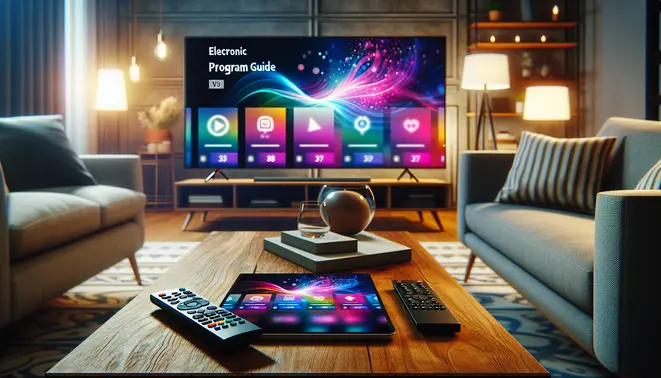IPTV EPG The Complete Commercial Investigation And Subscription Guide

The IPTV Revolution – What You’re Really Getting Into
Internet Protocol Television (IPTV) represents a fundamental shift from traditional broadcast methods, delivering television content through internet networks instead of satellite signals or cable systems [Source: Grand View Research]. This technology enables viewers to stream media continuously, offering unprecedented flexibility in when and how they watch their favorite shows. Unlike conventional TV with fixed schedules, IPTV services provide on-demand access to movies, series, and live events through internet-connected devices including smart TVs, smartphones, tablets, and streaming boxes.
The global IPTV market has experienced remarkable growth, projected to reach $194.21 billion by 2030 according to Grand View Research. This expansion reflects consumer demand for personalized viewing experiences and the declining appeal of traditional cable packages with their rigid channel bundles and escalating costs.
The Critical Role of EPG in Your Viewing Experience
At the heart of every quality IPTV service lies the Electronic Program Guide (EPG), which serves as your navigation system through available content. A well-designed EPG transforms chaotic channel lists into an organized, searchable interface where you can quickly find what to watch. Modern EPGs display program schedules days in advance, provide detailed show descriptions, and often include features for recording series or setting reminders for upcoming episodes.
Advanced EPG systems now incorporate recommendation engines that analyze your viewing habits to suggest new content you might enjoy. This personalized approach to content discovery represents a significant improvement over traditional TV guides, which offered the same static listings to every viewer regardless of their interests. The difference between a frustrating and seamless IPTV experience often comes down to the quality of its EPG implementation.
Understanding What You’re Really Getting With IPTV
When evaluating IPTV providers, consumers should recognize that not all services deliver equal value. Legitimate IPTV operations partner with content creators and distributors to offer licensed programming through secure platforms. These services typically provide reliable streaming quality, consistent channel availability, and proper customer support. However, the market also contains unverified providers offering suspiciously low prices, which may indicate unauthorized content sources that could disappear without warning.
Before committing to any service, consider exploring our comprehensive guide to IPTV free trials to test different platforms. Additionally, our complete IPTV subscription guide provides detailed comparisons of leading providers to help you make an informed decision.
The IPTV revolution offers genuine advantages including cost savings, content flexibility, and multi-device compatibility. Nevertheless, understanding the technology’s components—particularly the crucial role of a functional EPG—ensures you select a service that delivers both entertainment value and reliable performance for your viewing needs.
EPG Demystified – Your TV’s New Best Friend
An Electronic Program Guide (EPG) is the digital interface that displays television programming schedules, allowing viewers to navigate channels, browse upcoming shows, and access detailed program information. Unlike traditional printed TV guides, EPGs provide real-time data and interactive features that transform how you discover and watch content. Modern EPGs serve as comprehensive entertainment hubs, offering search functionality, program categorization, and one-click recording options.
Why EPG Quality Defines Your IPTV Experience
The quality of your Electronic Program Guide directly impacts your overall viewing satisfaction with IPTV services. A well-designed EPG delivers accurate program information, intuitive navigation, and reliable scheduling data that keeps you informed about your favorite shows. Conversely, poor EPG implementation can lead to frustration with incorrect listings, limited program details, and clunky interface design that undermines the premium streaming experience you expect.
Premium IPTV providers distinguish themselves through superior EPG systems that offer comprehensive channel coverage, minimal data errors, and regular updates. According to industry analysis, EPG accuracy remains a critical factor for subscriber retention in competitive streaming markets. Meanwhile, services with inconsistent program guides often struggle with customer dissatisfaction and higher churn rates.
The Technical Foundation Behind Reliable EPGs
Behind every functional Electronic Program Guide lies complex technical infrastructure that ensures accurate and timely program data delivery. EPG systems rely on standardized data formats like XMLTV to gather scheduling information from multiple sources, including broadcast networks, production studios, and content aggregators. This data undergoes validation and processing before being distributed to subscribers’ devices through specialized servers.
The reliability of an EPG depends heavily on the provider’s commitment to maintaining their data infrastructure and update protocols. Regular synchronization with official programming databases ensures that last-minute schedule changes, sporting event adjustments, and breaking news coverage updates reflect accurately in your guide. Technical maintenance also prevents common issues like missing program descriptions, incorrect time zones, or outdated channel lineups that can frustrate viewers.
The Commercial Investigation – What Providers Don’t Want You to Know
The Hidden Cost Structure of IPTV Services
Many IPTV providers advertise attractively low monthly rates, but these prices often conceal a complex web of additional expenses. While the base subscription might seem affordable, customers frequently encounter mandatory equipment purchases, activation fees, and premium channel add-ons that significantly increase the total cost. Moreover, some providers require annual payments upfront, locking users into services that may not deliver consistent quality over time.
Beyond the advertised price, consumers should investigate regional licensing fees that some providers pass along to customers. These hidden charges can appear months into a subscription, catching users by surprise. Additionally, many services impose extra costs for features like DVR functionality, multiple simultaneous streams, or 4K content access—features that are often included in legitimate streaming services at no additional charge.
Legal Gray Areas and Consumer Risk
The IPTV industry operates in a legal gray area that poses significant risks for consumers. Many providers lack proper licensing agreements with content creators and broadcasters, making their services potentially illegal in many jurisdictions. According to recent legal analysis, using unlicensed IPTV services could expose consumers to legal liability, including copyright infringement claims.
Content creators and broadcast networks have intensified their efforts to shut down unauthorized IPTV operations through coordinated legal actions. Major sports leagues and entertainment companies have successfully pursued lawsuits against both providers and users of illegal streaming services. This legal landscape means that consumers risk sudden service disruptions and potential legal consequences when using unverified IPTV providers.
Reliability Concerns and Service Instability
Unlike legitimate streaming platforms that maintain robust infrastructure, many IPTV services suffer from chronic reliability issues. Subscribers frequently report service interruptions during peak viewing hours, especially during major sporting events when server capacity becomes strained. These disruptions often occur without warning and can last for extended periods, leaving customers without the service they’ve paid for.
The technical infrastructure supporting many IPTV providers is often inadequate for consistent high-quality streaming. Users commonly experience buffering, pixelation, and sudden channel outages that legitimate services have largely eliminated through substantial infrastructure investment. Furthermore, when technical problems arise, customer support is frequently unavailable or unable to resolve issues promptly.
Setting Up Your IPTV Empire – A Step-by-Step Guide
Choosing Your Streaming Device
Your first step in building a reliable IPTV empire is selecting the right hardware. The choice of streaming device directly impacts your viewing quality, app compatibility, and overall user experience. For a seamless setup, consider popular options like the Amazon Fire TV Stick 4K Max, NVIDIA Shield TV Pro, or Formuler devices. These platforms offer robust processing power and dedicated IPTV player support, ensuring smooth playback of high-bitrate streams.
When evaluating devices, prioritize those with ample storage and RAM. This prevents buffering during peak viewing hours and allows for the installation of multiple entertainment apps alongside your IPTV service. For a deeper analysis of the best hardware for your needs, explore our comprehensive streaming devices guide.
Selecting a Reliable IPTV Service Provider
With your hardware ready, the next critical decision is choosing a subscription service. A premium IPTV provider delivers consistent uptime, a vast channel selection, and high-quality video-on-demand (VOD) libraries. Look for services that offer comprehensive global content, including live sports, news, and international channels.
Always test a service before committing long-term. Many reputable providers offer IPTV free trials, allowing you to evaluate stream stability and channel variety. Our complete IPTV subscription guide can help you compare features and identify trustworthy providers.
Configuring Your Electronic Program Guide (EPG)
An EPG is the digital TV guide that transforms a simple channel list into a navigable entertainment hub. It displays program schedules, show descriptions, and air times. A properly configured EPG is essential for a premium viewing experience, allowing you to browse upcoming shows and set reminders.
Your IPTV service provider should supply an EPG source URL. Enter this URL into your IPTV player’s settings, usually found in the EPG or XMLTV section. The player will then populate your guide with data. If you encounter missing information, you can often supplement it with free, public EPG sources available online [Source: IPTV Tools].
Optimizing Your Network for IPTV
A stable, high-speed internet connection is non-negotiable for buffer-free streaming. For standard definition (SD) streams, a minimum of 10 Mbps is recommended. However, for high-definition (HD) or 4K content, aim for at least 25 Mbps. For the best performance, use a wired Ethernet connection instead of Wi-Fi whenever possible.
If you must use Wi-Fi, ensure your router is placed close to your streaming device and operates on a less congested 5 GHz band. Additionally, consider using a quality VPN service. A VPN can help bypass ISP throttling—a practice where internet providers intentionally slow down streaming traffic—and can also provide an added layer of privacy [Source: Digital Trends].
EPG Features That Will Transform Your Viewing
Smart Scheduling and Recording
Modern IPTV Electronic Program Guides (EPGs) offer powerful scheduling and recording capabilities that go far beyond traditional TV guides. With one-click recording, you can capture entire series, ensuring you never miss an episode of your favorite shows. Advanced EPGs automatically detect new seasons and episodes, adding them to your recording schedule without manual intervention.
Series Link functionality has become increasingly sophisticated, allowing viewers to set recording preferences for specific actors, directors, or even themes. This means your EPG can automatically record content matching your unique interests, creating a personalized viewing library. Meanwhile, cloud-based recording solutions eliminate storage limitations, enabling you to build an extensive media collection accessible from any device.
Intelligent Content Discovery
Today’s advanced EPGs employ sophisticated recommendation engines that analyze your viewing patterns to suggest content you’ll genuinely enjoy. These systems use machine learning algorithms to identify patterns in your watching habits, then cross-reference this data with similar user profiles to uncover hidden gems. The result is a constantly evolving selection of recommendations that become more accurate over time.
Many EPGs now incorporate social features, allowing you to see what friends are watching and get recommendations based on their preferences. Some platforms even integrate with review aggregators like Rotten Tomatoes and IMDb, providing critic and audience scores directly within the program guide. This comprehensive approach to content discovery transforms how viewers find new entertainment options.
Advanced Search and Filtering
Sophisticated search functionality represents another game-changing EPG feature. Voice-activated search allows you to find content using natural language queries like “show me action movies from the 90s” or “find romantic comedies with Sandra Bullock.” The system understands context and relationships between search terms, delivering highly relevant results.
Advanced filtering options enable viewers to narrow down content by multiple criteria simultaneously, including genre, release year, rating, language, and even specific technical features like 4K resolution or Dolby Atmos support. These filters work across live TV, on-demand content, and your personal recordings, creating a unified discovery experience. For those exploring IPTV options, our IPTV free trial guide explains how to test these advanced features before committing.
Cross-Device Synchronization
Modern EPGs maintain perfect synchronization across all your devices, ensuring a seamless viewing experience whether you’re watching on your television, tablet, or smartphone. Start watching a movie on your living room TV, pause it, and resume exactly where you left off on your mobile device during your commute. This continuity extends to your recording schedule, watchlist, and even playback preferences.
The synchronization also applies to your personalized recommendations and viewing history. As you watch content on different devices, the EPG continuously updates your profile, refining its understanding of your preferences. This creates a consistently personalized experience regardless of which screen you’re using. For viewers considering different service options, our complete IPTV subscription guide compares how various providers implement these synchronization features.
The Cost-Benefit Analysis – Is IPTV Really Worth It?
Breaking Down the Monthly Costs
When comparing entertainment options, the monthly subscription fee is the most obvious starting point. Traditional cable packages typically range from $50 to $150 per month, with premium channels and sports packages pushing costs even higher. In contrast, major streaming services like Netflix, Hulu, and Disney+ operate on a per-service model, with individual subscriptions costing $7 to $20 monthly. However, subscribing to multiple services to access desired content can quickly add up.
IPTV services present a different financial model. Many providers offer access to thousands of live channels, video-on-demand (VOD) content, and premium networks for a fraction of the cable cost. Monthly IPTV subscriptions often fall between $10 and $20, with significant discounts for longer-term commitments like quarterly or annual plans. This price disparity makes IPTV an attractive proposition for budget-conscious viewers [Source: Digital Trends].
The Hidden Expenses Beyond the Subscription
While the base subscription is important, the total cost of ownership includes several additional factors. Cable companies are notorious for hidden fees, including broadcast TV fees, regional sports network surcharges, and equipment rental costs for set-top boxes and DVRs, which can add $20 to $50 to your monthly bill.
Streaming services generally have fewer hidden costs but require a reliable, high-speed internet connection, which is a separate expense. Furthermore, to achieve a comparable channel selection to cable or IPTV, you often need to subscribe to multiple streaming platforms, a strategy known as “subscription stacking.”
IPTV also has potential hidden costs. A stable internet connection is mandatory. Additionally, while our guide on the best IPTV subscriptions covers various apps, some services may work best with specific devices or require a more powerful streaming box for optimal performance, representing an upfront hardware investment.
Content Library and Channel Comparison
The value of any service is directly tied to the content it provides. Cable offers a structured, familiar channel lineup with local broadcasts, but often bundles unpopular channels with desirable ones. Streaming services excel at original series and vast on-demand libraries but may lack immediate access to live news and sports.
This is where IPTV’s value proposition becomes compelling. A single IPTV subscription can provide an enormous selection of live TV channels from around the world, including premium sports networks, pay-per-view events, and international content that is often expensive or unavailable through other means. For households with diverse viewing tastes, this extensive library can justify the low cost. [Source: Forbes Advisor]
The Final Verdict on Value
So, is IPTV worth it? From a purely cost-versus-content perspective, IPTV offers unparalleled value, providing access to a massive volume of live and on-demand content for a low monthly fee. It is the clear winner for cord-cutters seeking maximum channels for minimum cost.
However, this value comes with trade-offs. You must be willing to navigate potential reliability issues, conduct thorough research to find a stable provider, and understand the legal implications of the service you choose. For those who prioritize guaranteed uptime, seamless integration, and absolute legality, the higher cost of traditional cable or a curated bundle of streaming services may be the more prudent investment.
Future-Proofing Your Entertainment – What’s Next for IPTV & EPG
The Evolution of IPTV Technology
The IPTV landscape is undergoing rapid transformation as emerging technologies reshape how we consume television content. Artificial intelligence now powers sophisticated recommendation engines that learn from viewing habits to suggest personalized content. [Source: IBC] Meanwhile, 5G networks are enabling higher-quality streaming with reduced latency, making 4K and even 8K content more accessible to mobile viewers.


